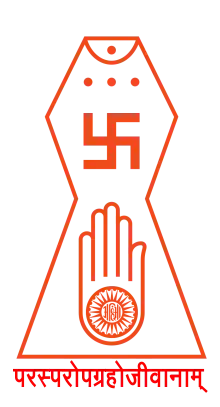Kshullak
A kshullak (or kshullaka, lit. small or junior) is a junior Digambar Jain monk.[1] A kshullak wears two garments as opposed to a full monk who wears no clothes.[2] Specifically a Kshullaka is a Shravaka of the highest degree at 11th Pratima.

| Part of a series on |
| Jainism |
|---|
 |
|
|
A kshullak is sometimes referred to by the earlier title Varni, even though Varni corresponds to the seventh Pratima.
Well known kshullakas include:
- Kshullaka Ganeshprasad Varni
- Kshullaka Jinendra Varni
A Digambara Jain shravaka at the highest rank of 11th pratima is either a kshullaka or an ailaka. He is just one step below a full muni. His conduct is prescribed in Vasunandi Sravakachara and Lati Samhita.
A kshullaka wears a loin cloth (kaupina) and a white rectangular cloth as a wrap. An ailak uses only a loin cloth.
A kshullaka may live in a house or may be a wanderer. He may eat food placed in his palms, or from a container. He eats once a day. He may beg from a single house or from multiple ones.
A kshullaka may keep a yajnopavita and a shikha. In Jain tradition, Narada muni is assumed to be a Kshullak Jain monk.
Kolhapur in Maharashtra was also once known as Kshullakapur because of the presence of many Jain monks during the Shilahara rule.
Etymology
The Sanskrit term kṣullaka is a late Vedic corruption of an earlier kṣudraka and means "tiny, small, trifling".
See also
- Shramana
References
- http://www.hindu.com/2006/05/14/stories/2006051404820300.htm Jain muni initiates his father into dharmic order
- Jinendra Varni, Jainendra Siddhanta Kosa, V.2, pages, 188-189
External links
 Media related to Kshullak at Wikimedia Commons
Media related to Kshullak at Wikimedia Commons